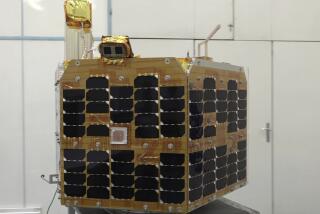Trump denies U.S. responsibility for destruction of Iranian rocket launch
- Share via
WASHINGTON — One day after an Iranian rocket appeared to explode on its launchpad, President Trump denied U.S. responsibility Friday for the extensive damage and released an unusually detailed aerial photo of the debris-strewn launch site.
His denial seemed geared to limit speculation that the explosion was caused by a cyberattack, an increasingly common but normally covert mode of attack that U.S. forces have used against Iran in the past.
In his tweet, Trump appeared to reach out to officials in Tehran after months of mounting tensions. “I wish Iran best wishes and good luck in determining what happened,” he wrote.
But the tweet also carried a surprise — a high-resolution reconnaissance image of the damaged Imam Khomeini Space Center in northern Iran, with annotations identifying damaged vehicles and scorched facilities.
Experts on satellite imagery said the photo’s resolution surpasses the clarity of satellite images on the commercial market, suggesting that Trump had shared classified material on his decidedly unclassified Twitter account.
“My jaw dropped seeing this,” said Ankit Panda, an adjunct senior fellow at the nonpartisan Federation of American Scientists. “We’re telling all of our adversaries the level of optical imagery we’re able to obtain from space-based assets.”
It’s unclear how the image made it to Trump’s Twitter feed. It appears to show the reflection of a camera flash, suggesting it may be a smartphone photo of another image — the kind that might have been shared with the president in his intelligence briefing Friday.
“This is wild,” said David Joseph Schmerler, a senior research associate at the Middlebury Institute of International Studies at Monterey, a graduate school. “This is something that the public can’t get their hands on unless the president decides to tweet it out.”
Schmerler has analyzed commercially available images of the launch site, and said many of the details were blurry. Trump’s tweet, by contrast, clearly shows damaged vehicles and large writing around the ring of the launchpad.
U.S. intelligence officials normally seek to protect reconnaissance capabilities. But presidents are authorized to declassify any information they want, and Trump defended his decision.
“We had a photo and I released it, which I have the absolute right to do,” he told reporters outside the White House before heading to the presidential retreat at Camp David in northern Maryland for the weekend.
“The president does have the ability to declassify things if he or she wants to do so,” said Eric Brewer, who served as director for counter-proliferation at the National Security Council until last year. “But normally there’s an attempt to understand the risks or benefits of taking such a step.”
Trump has faced criticism for loosely handling sensitive information before. In May 2017, he sparked controversy when he shared highly classified intelligence, reportedly from Israel, with the Russian foreign minister.
Trump’s tweet comes at a delicate time for U.S. relations with Iran. Trump has increased sanctions on Tehran and pulled out of the landmark 2015 nuclear agreement with Iran, claiming it was flawed. But he signaled last week that he’s willing to meet with Iranian President Hassan Rouhani to reopen negotiations.
The U.S. has used cyberattacks against Iran in the past, such as working with Israel to deploy the Stuxnet computer worm to sabotage centrifuges in Iran’s nuclear enrichment program prior to 2010.
In addition, the New York Times recently reported that U.S. Cyber Command successfully targeted Iranian paramilitary forces this summer to limit their ability to attack oil tankers in the Persian Gulf.
More to Read
Get the L.A. Times Politics newsletter
Deeply reported insights into legislation, politics and policy from Sacramento, Washington and beyond. In your inbox three times per week.
You may occasionally receive promotional content from the Los Angeles Times.











